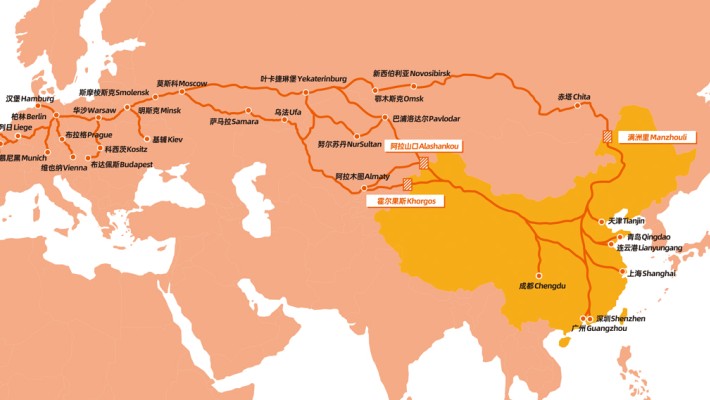Freight Forwarder Insights
Huin International Logistics Latest Articles
One Belt One Road Initiative
The One Belt One Road (OBOR) Initiative represents a monumental, long-term strategy launched by the Chinese government with the cooperation of numerous other nations. This ambitious project aims to boost international trade and improve logistics in support of global economic development. China's persistent advocacy for international collaboration seeks to drive collective investment into enhancing trade and infrastructure. The goal is to develop greener, more efficient, and sustainable solutions for the global transportation and logistics sector. Conceived in 2013, the OBOR initiative seeks to establish commercial and infrastructure networks linking China with countries in Europe and Africa—a modern counterpart to the historic Silk Road.
In today’s discussion, we will explore the significance of this initiative for international shippers, port operators, and the wider freight forwarding industry.
Understanding the One Belt One Road Initiative The One Belt One Road is one of the largest regional collaborative projects ever undertaken. It comprises two main components: the "belt," which refers to overland routes connecting Asia to Europe, extending as far as Rotterdam, Moscow, and Venice; and the "road," a maritime route that modernizes the ancient Silk Road by connecting shipping lanes from Asia to Africa and Europe. As of 2018, the OBOR project encompasses over 71 countries, involving approximately 65% of the global population and roughly 38.8% of global GDP. The vast scope of this initiative promises to profoundly transform the transportation and logistics industry.
The OBOR initiative plans to create new routes and modes of transport to facilitate international trade. Scheduled for completion by 2049, the project aims to mitigate cross-border challenges through a reimagined supply chain and business development model. Several innovations are already underway, with others in the developmental phase. These advancements are designed to improve operational efficiency and bolster trade. However, achieving the full benefits of this initiative requires international cooperation, the utilization of advanced technologies, and new work processes. Beyond constructing infrastructure such as ports, roads, and railways, the project aspires to develop a global transportation and logistics network linking territories with substantial economic growth potential.
The Scope and Impact of OBOR The OBOR initiative will enable manufacturers to better manage their distribution processes by focusing on infrastructure improvements, including high-speed freight trains, maritime routes, and energy generation projects. Reduced transport times will lower costs, benefiting inventory management within the supply chain. The accelerated movement of goods encourages manufacturers to innovate rapidly without compromising quality. It also decreases transit times between distant markets, enhancing logistical practices and reducing excess inventory.
Another significant benefit of the OBOR project is enhanced supply chain resilience. Improving the quality and reliability of logistical infrastructure will increase supply chain robustness, visibility, and collaboration among logistics companies. This will help these companies manage supply chain disruptions more effectively, thereby facilitating increased and seamless international trade, attracting more buyers, and offering more choices for consumers.
Benefits for Europe Europe is already capitalizing on this project for product and service exchange via ocean routes. For instance, Chinese multinational Cosco Shipping has acquired a 51% stake in the Port of Piraeus in Greece, transforming it into a maritime hub linking Asian ocean freight with multiple European markets through rail and road transport. This has significantly reduced shipping time and costs, further spurring the growth of e-commerce.
China's strategic port acquisitions in Europe are central to its maritime ambition to connect Chinese and European ports. The increasing number of European ports under Chinese control is reshaping the international trade map. Italy, for instance, is partnering with China to strengthen investment and commercial relations, alongside digital collaborations involving technologies like Internet Plus. France has also signed several bilateral agreements to enhance cooperation.
In essence, China’s port acquisitions in OBOR-participating countries are escalating, poised to significantly impact the global shipping industry. This initiative has modernized China's manufacturing processes, setting the stage for future investments. However, political relations between China and OBOR participants could pose challenges. The ultimate impact remains to be seen as the situation evolves.
Opportunities for African Nations The Belt and Road initiative not only encourages Chinese investments abroad but also promotes global investment into China along the OBOR routes. This provides African companies the opportunity to collaborate with China on new projects. Chinese multinationals are likely to seek local partners for projects in various African nations. President Xi Jinping has stated that African countries will benefit from this initiative, as "inadequate infrastructure is the biggest bottleneck to Africa’s development." Furthermore, the OBOR is viewed as a catalyst for regional economic growth in Africa. If East African nations leverage these projects effectively, their exports could increase by up to $192 million annually.
In line with this initiative, China is more prepared to finance African projects, and the OBOR will also strengthen Chinese anti-piracy efforts in Africa, positively impacting maritime trade. Additionally, Chinese private companies are already investing in African sectors such as tourism, agriculture, real estate, and infrastructure.
Conclusion The OBOR initiative is poised to reshape the future of the international transportation and logistics industry. By integrating ports with rail and road networks, it will enhance speed and efficiency. However, successful implementation will require overcoming significant risks and challenges. Strong partnerships and a robust intercontinental support network are critical. While the project is already underway, the industry's future is on the verge of transformation. Companies that fail to adapt to this evolving model risk obsolescence.
